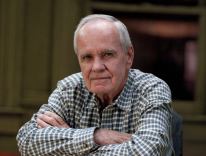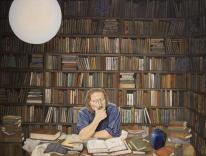Living Vatican II
The 21st Council for the 21st Century
Gerald O’Collins, SJ
Paulist, $19.95, 243 pp.
___________________________________________________________________
Gerald O’Collins is the beau ideal of the contemporary Catholic theologian: extremely well educated, possessed of a keen analytical mind, a clear writer and thinker, and, above all, a faithful servant dedicated to the good of the church (which does not mean that he simply parrots magisterial statements).
An Australian by birth, O’Collins recently retired after three decades of teaching fundamental theology at Rome’s Gregorian University. When I once tried to lure him away from Rome to the more austere joys of teaching in northern Indiana, he told me that his place was in Rome where he could mold the education of students who came from all over the world, especially the newly freed countries of Eastern Europe and the burgeoning churches in the Southern Hemisphere. O’Collins understands the meaning of the term catholic church and he has shaped his professional life accordingly.
Living Vatican II is part autobiography, part theological reflection. O’Collins examines the documents of Vatican II with two questions in mind. One, to what extent has the church around the world harnessed the power of the council? Two, have church leaders facilitated the implementation of the council, or have they acted as self-appointed gatekeepers and “only let some things through.”
Only someone well acquainted with church documents and the Roman way of doing things can observe and evaluate the conduct of the “gatekeepers.” For example, in a few careful pages O’Collins discusses the hot-button issue of liturgical translations. He notes the dissonance between the Code of Canon Law’s stipulation that bishops’ conferences are responsible for translations and the Congregation for the Sacraments’ insistence on screening all texts (thus arguing that they know Japanese better than the Japanese bishops). O’Collins also provides a nuanced analysis of the International Theological Commission (ITC), which was created by Paul VI in 1969. Paul VI wanted the ITC to feature a range of opinion, which is why both Hans Urs von Balthasar and Karl Rahner were appointed. Yet according to O’Collins, since the 1970s there has been a “decline in quality, in part because the members were recruited only among safe conservatives” and, as a consequence, “do not represent the pluralism the Synod of Bishops asked for in 1967 and Paul VI ‘willingly allowed’ in his inaugural address.” The consequence is that most of what they report is “widely ignored.”
Lest anyone think that this is a book-length kvetch about how things work across the Tiber from the Gregorian, no need to worry: O’Collins is an eternal optimist. He has “dreams” about how to make the pastoral work of bishops and priests more joyful and fulfilling. He has a deep love for Jesus Christ, which he has expressed in a series of works on Christology and the Resurrection. Living Vatican II has some powerful pages on the symbiotic nature of theology, Christian witness, and service to the People of God.
In his final chapter, O’Collins reflects on the “coming church” with a deep sense of hope. He emphasizes the importance of “creative fidelity.” To be merely faithful to the magisterium, he writes, runs the risk of assuming that the church is a finished project. To be creatively faithful, on the other hand, is to understand that we are a pilgrim people who have not yet reached our destination, so there is much work to be done.
Among the subjects O’Collins discusses are the synods that were held in Rome during the papacy of John Paul II. It is no secret that many bishops found the synods unsatisfactory because the agendas were set by the Roman curia. Discussion was limited to five-minute “interventions” in which bishops gave prepared statements. Unfortunately, bishops were not encouraged to say what they really had in mind, and the final reports were crafted by curial officials. This Potemkin-village structure prevented any serious discussion of substantive issues.
____________________________________________________________________
Practices of Dialogue in the Roman Catholic Church
Bradford Hinze
Continuum, $39.95, 326 pp.
____________________________________________________________________
Synods, and other experiments in church dialogue, are the subject of Bradford Hinze’s Practices of Dialogue in the Roman Catholic Church. His book focuses on the postconciliar period, with special emphasis on events in North America. He writes about parish councils and diocesan synods, and describes the (in)famous Call to Action conference of 1976, which ended in a farrago of name-calling and division. He examines the process of consultation behind the U.S. bishops’ pastoral letters of the 1980s, raising important theological questions about how much authority such collective works have. He also analyzes the Catholic Common Ground Initiative which, while still ongoing, tends to fly under the radar screen of Catholic consciousness. Other chapters discuss the workings of women’s religious communities (the Adrian Dominicans in particular), and ecumenical and interreligious dialogues.
Near the end of the book, Hinze quotes Cardinal Avery Dulles, who argues that we still lack a theological approach to dialogue. Dulles and Pope Benedict XVI favor dialogue along classical Augustinian and personalist lines-a model proposed by John Paul’s encyclical Ut unum sint. Hinze is critical of this model because it grants ultimate authority to the hierarchy, and works from the a priori assumption that consultation with the faithful merely deepens a truth already held.
Drawing on the work of the late Bernard Lonergan, Hinze proposes another model of dialogue, one that seeks to highlight the hidden biases and ideologies that hinder authentic communication. Unlike the model offered by Dulles et al., this more nuanced understanding of dialogue takes into account the polarizations that have characterized so much of church life in the past half-century. We are nowhere close to understanding how such a theory of dialogue might function in practice but, as Hinze rightly points out, at a minimum we need a theology that more fully accounts for the relationship between the ordained and “the baptized faithful, who have received a mandate to participate fully and actively in the life and mission of the church.”
____________________________________________________________________
The Shadow of God
A Journey through Memory, Art, and Faith
Charles Scribner III
Doubleday, $24.95, 291 pp.
____________________________________________________________________
Charles Scribner’s name is immediately recognizable to anyone who reads: he is the great-great grandson of the founder of one of America’s most distinguished publishers. Readers of a certain age will remember Scribner’s elegant bookstore on Fifth Avenue, now, alas, a fashion boutique. Whenever I see its art nouveau façade (which is still intact), I think of Thomas Merton buying a copy of Etienne Gilson’s The Spirit of Medieval Philosophy there in the late 1930s, a crucial moment in his conversion.
A few years ago Scribner, a convert to Catholicism, was asked by his parish priest to give a talk on what God means in his life. Inspired by that request, he decided to keep a journal for a year chronicling his daily life in tandem with reflections-St. Augustine calls it “roaming the spacious halls of memory”-on why he decided to join the church.
Scribner has all of the silvered credentials: scion of a famous family, education at St. Paul’s and Princeton, membership in St. Bartholomew’s Episcopal Church on Park Avenue, the means to spend time abroad, natural gifts in music. After college he pursued a degree in art history and, in time, he became an editor with the family firm. All of these experiences are described in this wonderfully written book, along with his experiences as a Catholic who serves, among other things, as a cantor at St. Patrick’s Cathedral.
Scribner converted to Catholicism while an undergraduate at Princeton. The artistic patrimony of Catholicism helped spur his conversion, but he knew that, from a liturgical perspective, he was exchanging the stunning beauty of the Book of Common Prayer for the more jejeune vernacular of the Roman Catholic liturgy. Like all converts from Canterbury (Newman, Hopkins, Knox, and others), Scribner made a sacrifice in his conversion. What Scribner understands is that while great art can steer one toward faith, it can also reinforce and deepen one’s faith when discovered a second time. If there is a thesis in this book-and few write memoirs to prove a thesis-it is that music and art can teach us about faith.
The Shadow of God makes that point effortlessly, and it rings true to this theologian. The Baroque period did not witness great advances in Catholic theology, however fecund we might find the work of the great Baroque scholastics. That time period-the age of the Catholic Reformation-restated the ancient faith best in art, architecture, poetry, and music. In Bernini’s Ecstasy of Saint Teresa the discriminating eye sees a pivotal moment from her autobiography enshrined in stone. Similarly, as the late Jaroslav Pelikan amply demonstrated, one can learn a great deal about Lutheran theology by listening to Bach.
This book is framed between the 2002 and 2003 feasts of Epiphany. As Scrib¬ner notes in his introduction, he is not writing about a season in Provence or Tuscany, but a year of seasons based on the liturgical calendar. The Catholic liturgy is the place where word, art, and music come together to point to a greater reality. It has been a most fruitful exercise for me to accompany this gifted writer over the year, to be allowed to “follow the star” with him and to do it, to borrow from the book’s title, sub umbra Dei-under the shadow of God.
____________________________________________________________________
The Jesuits and the Arts
1540-1773
Edited by John O’Malley, SJ, and Gauvin Alexander Bailey
Saint Joseph’s University Press, $50, 477 pp.
____________________________________________________________________
St. Joseph’s University in Philadelphia deserves kudos for revamping this volume on Jesuit art, which was published in French, Italian, and Spanish editions in 2003. Brilliantly reproduced with color illustrations, this is a feast for both the eye and the mind, made all the more appealing by its modest price. I am only sorry that I could not carry it with me on a recent trip to Rome, but it is a hefty work, measuring fourteen-by-nine inches.
John O’Malley, the doyen of Jesuit studies in this country, explains how the original Jesuits ended up with such a deep artistic heritage-something that occurred almost by happenstance, a byproduct of the order’s larger mission of evangelization and teaching. Jesuits and the Arts includes excellent chapters on the society’s original churches in Rome, the Gesu and Sant’Ignazio, which feature baroque decorations by the Jesuit brother Andrea Pozzo and such Roman luminaries as Vignola, Fontana, and, of course, Bernini. Other chapters trace the evolution of Jesuit architecture in Europe, the attempts to find an authentic likeness of St. Ignatius (he resisted sitting for a portrait during his lifetime), and the subsequent growth of Jesuit art and architecture in the East, in the Americas, and in China and India.
I found the sections on the spiritual devotions preached by the Jesuits during the Catholic Reformation most intriguing. There are excellent pages on the devotion to the Holy Name of Jesus, and ample illustrations of the emerging devotions of the “Forty Hours” and to the Sacred Heart. The book also reprints various images of the Blessed Virgin from the period, which have roots in earlier portraits of Mary as Savior of the Roman People. To echo a point I made earlier, the age of the Catholic Reformation may not be known for the originality of its theology, but the variety of spiritual devotions that developed during this period is remarkable.
One can also learn a great deal about missionary inculturation from this book. Jesuits like Matteo Ricci in China and Philip de Nobili in India are justly famous for their missionary activities, and much of the art displayed here reflects those efforts. Also featured are Japanese paintings by Nobukata that reflect hidden Christian themes. Nobukata used Western techniques, while the Chinese Jesuit Wu Lei worked in traditional Chinese styles. To me the most revelatory works were produced in the early seventeenth century in India on paper: they look very much like the Mughal miniatures one sees in museums. A striking example, now in the Cleveland Museum of Art, shows Elijah, being fed by ravens, wearing the traditional sacred orange of Hindu ascetics. Another piece, also in Cleveland, shows St. John the Baptist greeting Christ before an audience of Sufi mystics and Islamic mullahs.
Jesuits and the Arts also pays fair attention to Jesuit drama, and ends with an excellent essay on the Jesuits and music. This book will interest those who love the arts, and those fascinated by the Catholic experience as refracted through the charism of the followers of Ignatius of Loyola.
Please email comments to [email protected] and join the conversation on our Facebook page.
Share
Previous Story
Could the Church Have Gotten It Wrong?
Next Story
Uncharted Waters


